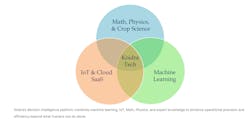When we think about modernizing manufacturing, automation is the first thing that comes to mind, specifically in the form of robots and integrated lines of machines. But for Kenneth Tran, the founder and CEO of Koidra Inc., a Seattle-based startup, automation is key, but when optimizing output, the focus should be on industrial controllers.
According to Tran, who for several years was a principal research engineer working on machine learning algorithms at Microsoft, there is a basic problem that impairs operational efficiency. It stems from the machine controller—that PLC that has behaved the same way for decades—which follows static, hard-coded instructions implemented by automation engineers during the time of project development. It is hard to update that PLC ladder logic that executes the program.
Meanwhile, however, depending on who is operating the machine, what data is being collected, and the environmental conditions, the machine runs differently. This lack of consistency is hard to overcome.
This became clear to Tran while he was working at his family’s biomass production facility in Vietnam which was built with traditional PLC, HMI, and SCADA technology. The dryer machines, for example, were not operating efficiently, and when he would ask operators why, they gave different answers. He couldn’t figure it out on his own either because the PLCs were not equipped to receive data from different sources and therefore could not present the big picture view of what was going on in a format that was understandable.
So Tran was on a mission to improve the processes without getting into the weeds of complex and expensive programming. Instead, he pulled the PLC source data to an edge computer running artificial intelligence IoT software, which added sensor data and operational parameters. Without getting into the ladder logic, they were able to apply a low-code language to improve control logic and algorithms for optimizing operations.
Subsequently, that turned into the commercial Koidra IoT Suite, which was on display at PACK EXPO International in Chicago in October. The industrial IoT platform can be integrated with sensors, existing control systems, and databases or legacy systems for data management. That information is then brought into Koidra’s user-friendly web interface, called Opera, which enables operators to define control strategies and change operating conditions using a low-code Excel-like option vs. using ladder logic.The Koidra decision intelligence platform solves the problem associated with antiquated industrial automation that sits static in ladder logic programs, and the data silos that lack interoperability among machine control systems. It also creates scalability and easy operational interfaces for unskilled workers.
“We advanced automation technologies using modern software engineering practices, moved it to the cloud, and made it operator-friendly,” Tran said.
The automation logic exists as a layer above the PLC to augment it, but in some cases, like new dryers for the biomass facility, the Koidra technology is used as a soft PLC for micro control of machines.
It can also automate set point logic, which was demonstrated in the autonomous greenhouse challenge, organized by Wageningen University and Research in the Netherlands, that Tran has personally participated in multiple times—and won.
This past summer, Koidra won the international contest for the second time, applying reinforcement learning, a subdomain of machine learning, which uses real-time decision making for optimization of control processes based on conditions.
The efforts have not gone unnoticed in the Agtech space, as Koidra was recently awarded a $3.77 million research grant by the U.S. Department of Agriculture, which it will share with Ohio State University, Rutgers University, Cornell University, and the University of Arizona. The new grant will allow Koidra to work with the universities on the continued development and validation of data-driven decision making to help grow produce.
Now, there are new ways to grow things and scale operations. “We keep making modifications to the plant, and the automation needs to follow the modernizations,” Tran said.
Leaders relevant to this article:


